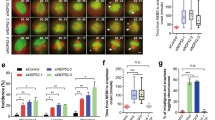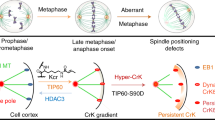Abstract
Coordination of spindle orientation with the axis of cell division is an essential process in all eukaryotes. In addition to ensuring accurate chromosomal segregation, proper spindle orientation also establishes differential cell fates and proper morphogenesis1. In both animal and yeast cells, this process is dependent on cytoplasmic microtubules interacting with the cortical actin-based cytoskeleton2,3,4,5, although the motive force was unknown. Here we show that yeast Myo2, a myosin V that translocates along polarized actin cables into the bud6, orientates the spindle early in the cell cycle by binding and polarizing the microtubule-associated protein Kar9 (refs 7,8,9). The tail domain of Myo2 that binds Kar9 also interacts with secretory vesicles12 and vacuolar elements13, making it a pivotal component of yeast cell polarization.
This is a preview of subscription content, access via your institution
Access options
Subscribe to this journal
Receive 51 print issues and online access
$199.00 per year
only $3.90 per issue
Buy this article
- Purchase on Springer Link
- Instant access to full article PDF
Prices may be subject to local taxes which are calculated during checkout




Similar content being viewed by others
References
Rose, L. S. & Kemphues, K. J. Early patterning of the C. elegans embryo. Annu. Rev. Genet. 32, 521–545 (1998).
Sullivan, D. S. & Huffaker, T. C. Astral microtubules are not required for anaphase B in Saccharomyces cerevisiae. J. Cell Biol. 119, 379–388 (1992).
Theesfeld, C. L., Irazoqui, J. E. Bloom, K. & Lew, D. J. The role of actin in spindle orientation changes during the Saccharomyces cerevisiae cell cycle. J. Cell Biol. 146, 1019–1032 (1999).
Palmer, R. E., Sullivan, D. S., Huffaker, T. & Koshland, D. Role of astral microtubules and actin in spindle orientation and migration in the budding yeast Saccharomyces cerevisiae. J. Cell Biol. 119, 583–593 ( 1992).
Goode, B. L., Drubin, D. G. & Barnes, G. Functional cooperation between the microtubule and actin cytoskeletons. Curr. Opin. Cell Biol. 12, 63–71 (2000).
Pruyne, D. W., Schott, D. H. & Bretscher, A. Tropomyosin-containing actin cables direct the Myo2p-dependent polarized delivery of secretory vesicles in budding yeast. J. Cell Biol. 143, 1931–1945 ( 1998).
Miller, R. K. & Rose, M. D. Kar9p is a novel cortical protein required for cytoplasmic microtubule orientation in yeast. J. Cell Biol. 140, 377–390 ( 1998).
Miller, R. K., Matheos, D. & Rose, M. D. The cortical localization of the microtubule orientation protein, Kar9p, is dependent upon actin and proteins required for polarization. J. Cell Biol. 144, 963– 975 (1999).
Schwartz, K., Richards, K. & Botstein, D. BIM1 Encodes a microtubule-binding protein in yeast. Mol. Biol. Cell 8, 2677– 2691 (1997).
Lee, L. et al. Positioning of the mitotic spindle by a cortical-microtubule capture mechanism. Science 287, 2260– 2262 (2000).
Korinek, W. S., Copeland, M. J., Chaudhuri, A. & Chant, J. Molecular linkage underlying microtubule orientation toward cortical sites in yeast. Science 287, 2257– 2259 (2000).
Schott, D., Ho, J., Pruyne, D. & Bretscher, A. The COOH-terminal domain of Myo2p, a yeast myosin V, has a direct role in secretory vesicle targeting. J. Cell Biol. 147, 791– 808 (1999).
Catlett, N. L. & Weisman, L. S. The terminal tail region of a yeast myosin-V mediates its attachment to vacuole membranes and sites of polarized growth. Proc. Natl Acad. Sci. USA 95, 14799–14804 (1998).
Stearns, T. Motoring to the finish: kinesin and dynein work together to orient the yeast mototic spindle. J. Cell Biol. 138, 957– 960 (1997).
Heil-Chapdelaine, R. A., Adames, N. R. & Cooper, J. A. Formin′ the connection between microtubules and the cell cortex. J. Cell Biol. 144, 809–811 (1999).
Adams, A. E. & Pringle, J. R. Relationship of actin and tubulin distribution to bud growth in wild-type and morphogenetic-mutant Saccharomyces cerevisiae. J. Cell Biol. 98, 934– 945 (1984).
Lille, S. H. & Brown, S. S. Immunofluorescence localization of the unconventional myosin, Myo2p, and the putative kinesin-related protein, Smy1p, to the same regions of polarized growth in Saccharomyces cerevisiae . J. Cell Biol. 125, 825– 842 (1994).
Walch-Solimena, C., Collins, R. N. & Novick, P. J. Sec2p mediates nucleotide exchange on Sec4p and is involved in polarized delivery of post-Golgi vesicles. J. Cell Biol. 137, 1495–1509 ( 1997).
Lillie, S. H. & Brown, S. S. Suppression of a myosin defect by a kinesin-related gene. Nature 356, 358 –361 (1992).
Beningo, K. A., Lillie, S. H. & Brown, S. S. The yeast kinesin-related protein sym1p exerts its effects on the class V myosin myo2p via a physical interaction. Mol. Biol. Cell 11, 691–702 (2000).
Kurihara, L. J., Beh, C. T., Latterich, M., Schekman, R. & Rose, M. D. Nuclear congression and membrane fusion: two distinct events in the yeast karyogamy pathway. J. Cell Biol. 126, 911–923 (1994).
Lee, L., Klee, S. K., Evangelista, M., Boone, C. & Pellman, D. Control of mitotic spindle position by the Saccharomyces cerevisiae formin Bni1p. J. Cell Biol. 144, 947–961 ( 1999).
Takizawa, P. A., Sil, A., Swedlow, J. R., Herskowitz, I. & Vale, R. D. Actin-dependent localization of an RNA encoding a cell-fate determinant in yeast. Nature 389, 90–93 (1997).
Long, R. M. et al. Mating type switching in yeast controlled by asymmetric localization of ASH1 mRNA. Science 277, 383– 387 (1997).
Mermall, V., Post, P. L. & Mooseker, M. S. Unconventional myosins in cell movement, membrane traffic, and signal transduction. Science 279, 527–533 (1998).
Chen, X. P., Yin, H. & Huffaker, T. C. The yeast spindle pole body component Spc72p interacts with Stu2p and is required for proper microtubule assembly. J. Cell Biol. 141, 1169–1179 (1998).
Tirnauer, J. S., O'Toole, E., Berrueta, L., Bierer, B. E. & Pellman, D. Yeast Bim1p promotes the G1-specific dynamics of microtubules. J. Cell Biol. 145, 993–1007 (1999).
Pruyne, D. & Bretscher, A. Polarization of cell growth in yeast. II. The role of the cortical actin cytoskeleton. J. Cell Sci. 113, 365–375 ( 2000).
DeZwaan, T. M., Ellingson, E., Pellman, D. & Roof, D. M. Kinesin-related KIP3 of Saccharomyces cerevisiae is required for a distinct step in nuclear migration. J. Cell Biol. 138 , 1023–1040 (1997).
Cottingham, F. R. & Hoyt, M. A. Mitotic spindle positioning in Saccharomyces cerevisiae is accomplished by antagonistically acting microtubule motor proteins. J. Cell Biol. 138 , 1041–1053 (1997).
Acknowledgements
We thank R. Miller, M. Rose, P. Novick, S. Lillie and D. Schott for advice and reagents. This work was supported by grants from the NIH.
Author information
Authors and Affiliations
Corresponding author
Rights and permissions
About this article
Cite this article
Yin, H., Pruyne, D., Huffaker, T. et al. Myosin V orientates the mitotic spindle in yeast. Nature 406, 1013–1015 (2000). https://doi.org/10.1038/35023024
Received:
Accepted:
Issue Date:
DOI: https://doi.org/10.1038/35023024
This article is cited by
-
Multivalency ensures persistence of a +TIP body at specialized microtubule ends
Nature Cell Biology (2023)
-
Kar9 symmetry breaking alone is insufficient to ensure spindle alignment
Scientific Reports (2021)
-
Pac1/LIS1 stabilizes an uninhibited conformation of dynein to coordinate its localization and activity
Nature Cell Biology (2020)
-
Differences in gene expression in whitefly associated with CYSDV-infected and virus-free melon, and comparison with expression in whiteflies fed on ToCV- and TYLCV-infected tomato
BMC Genomics (2019)
-
The actin capping protein in Aspergillus nidulans enhances dynein function without significantly affecting Arp1 filament assembly
Scientific Reports (2018)
Comments
By submitting a comment you agree to abide by our Terms and Community Guidelines. If you find something abusive or that does not comply with our terms or guidelines please flag it as inappropriate.



